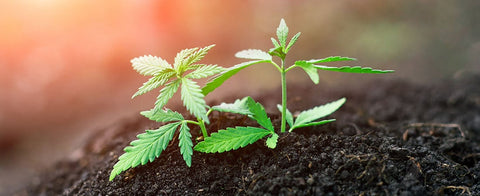Cannabis loves plenty of sunlight. For good growth and yield, it is important to choose a sunny location. If you haven't decided on a specific substrate yet, you can easily start cultivation in soil: in general, high-quality seed-starting soils, herb soils, or flower soils with light pre-fertilization that drain well are suitable for planting and further cultivation. If not already provided by the manufacturer, it is advisable to mix in 10-20% perlite.
Germination and Cultivation
Generally, germination and cultivation indoors can begin from mid-April.
Wrap the seeds loosely in damp kitchen paper, place them on a kitchen plate, and cover with a second, upside-down plate. This creates a dark, moist environment for germination. The germination temperature should be slightly above "room temperature" at 22-24°C; a good reference point and location for the plates is, for example, on top of a refrigerator. Check twice a day to ensure the seeds stay sufficiently moist; lightly moisten if necessary. The kitchen papers can also be changed every few days.
After about 7 days, the germ root should be visible. Once the germ root is about 1 cm long, the seed can be transplanted.

Fill a seedling pot (e.g. flower/herb pot, diameter 11 cm) loosely with soil and water it well, preferably 24 hours before transplanting the germinated seed. To transplant, form a hole about 0.5-1 cm deep in the moist soil, carefully place the germinated seed with the root facing down into the hole, and cover lightly with moist soil. To ensure even humidity and prevent the seedling from drying out, place a transparent drinking glass over the planting hole as a cover. A very comfortable option is to place the pots in a commercial seed tray with a lid and adjustable ventilation slots.

Next, move the pot/seed tray to a warm, bright location (e.g. a well-lit windowsill or conservatory). Good lighting is important to prevent excessive stretching growth of the seedling.
Within a few days, the first pair of leaves with rounded leaves (cotyledons) will emerge. If the drinking glass or cover fogs up heavily or shows signs of water droplets, lift or ventilate it several times a day. Once the second pair of leaves with serrated edges has formed, the drinking glass or cover can be removed.

Continue to keep the soil moderately moist, but never overwater. From mid-May and temperatures of 20-25°C, planting outdoors can take place. Nighttime temperatures should not fall below 10°C. The pre-grown plant can be placed in a larger pot (e.g. 11-liter pot or larger) with the chosen soil or in the open ground in humus-rich, loose soil. When growing in pots, make sure that excess water can drain properly from the pot.
Watering and Fertilizing
If the chosen soil is pre-fertilized by the manufacturer, the first fertilizing can usually begin after about two weeks. For beginners, a commercial "universal fertilizer" (nitrogen, phosphorus, potassium, magnesium, and micronutrients) such as COMPO Complete, applied according to the manufacturer's instructions, is typically sufficient.
Under good growth conditions, cannabis has a relatively high nutrient requirement; for older plants, it is recommended to follow the higher dosage guidelines from the fertilizer manufacturer. In the open ground, depending on the soil composition and nutrient content, a similar or lower amount of fertilizer may be needed. In rich garden soils, it may be possible to completely avoid additional fertilization. Water the plants according to their needs based on weather conditions. Especially when growing in pots, be careful not to use water that is too cold (at least 16°C). Allow the soil to dry out slightly between waterings, but avoid waterlogging! The general rule is: water less frequently with a larger amount of water rather than keeping the soil constantly moist. The latter affects the oxygen supply to the root zone.

Harvest
Once more than two-thirds of the flower hairs are brown, harvesting can typically take place in September/October, preferably on dry days; watch the weather forecast. Ideally, do not water the plants a few days before the planned harvest. Never harvest very wet plants (e.g. after rain).

Remove large leaves and hang the plants upside down on the stem in a dark, dry, well-ventilated place at 16-20°C to dry. Do not hang plants too closely together. Very large plants should be disassembled during harvest to ensure proper drying. Regularly check for mold and immediately remove any affected plant parts.



















Comments (0)
There are no comments for this article. Be the first one to leave a message!